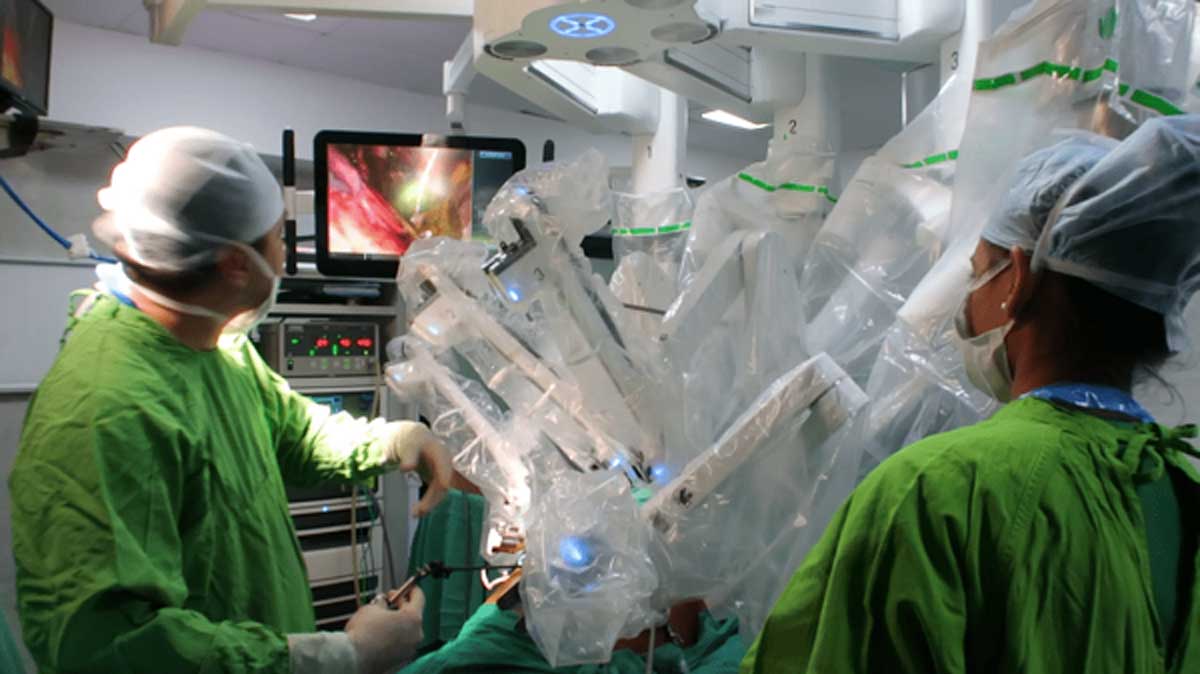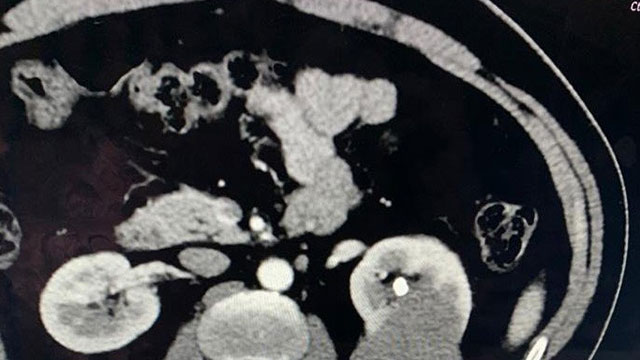Robotic Surgery In New Delhi India
Full information about Robotic Surgery in New Delhi, India
- What is robotic surgery
- What is minimally invasive surgery?
- How does the robotic surgical system work?
- Is the robot operating on me?
- Robotic surgery: what to expect:
- Recovery after Robotic Surgery: what is the post operative course?
- What are the benefits of robotic assisted surgery?
- What conditions can be treated with robotic surgery?
- Can any doctor perform robotic surgery?
- Is robotic surgery safe?
- What is the cost of Robotic surgery for prostate cancer treatment in India?
- The Future Of Prostate Surgery: Nerve-Sparing Robotic Prostatectomy With Amniotic Nerve Wrap!!
What is robotic surgery?
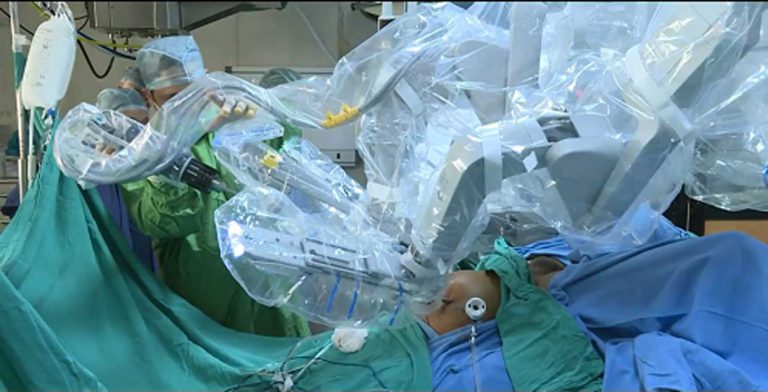
The robotic surgery is done with the Da Vinci surgical system, which includes:
- specialised “Robotic arms” to hold the instruments and the camera, along with
- “magnification screen” to see magnified 3D HD images and a
- “Surgical console “where the surgeon sits to do the robotic surgery.
Benefits of robotic surgery:
Recovery from robotic surgery:
Concerns about robotic surgery
What is minimally invasive surgery?
Traditionally surgery was done by a big incision in the tummy. Minimally invasive surgery basically means doing surgery through small keyhole incisions. The benefits of minimally invasive surgery:
- shorter hospital stay
- Less bleeding
- Less scar formation
- Reduced risk of infections
- Quicker recovery to normal activities and work
How does the robotic surgical system work?
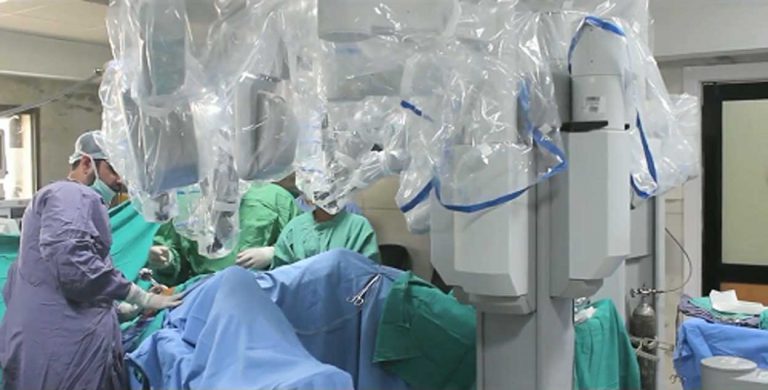
For information on robotic surgery in Delhi, watch this video https://youtu.be/JyTSPM90dcU
The robotic surgery is very “intuitive”. What this means is that it is like playing a car racing video game. When we are playing car racing we move the wheel, and the machine translates the movements into moving the car inside the video game right or left very precisely. Similarly during robotic surgery, when the surgeon moves the controls, these movements are translated into precise movements of the robotic arms inside the body. The surgeon is in full control of the movements of the robotic arms. The arms move only on the command of the surgeon.
Is the robot operating on me?
It is not the robot which is operating automatically on the patient.
The robot is just a machine which cannot “think”. It responds to the commands made by the surgeon.
As of now, all centres have only one type of robot i.e the Da Vinci Xi surgical system.
But the surgical outcomes are not determined by the machine but by the man behind the machine i.e. the operating surgeon.
Your robotic surgeon is in the operating room, directing the entire procedure.
Robotic surgery: what to expect:
During the procedure:
On the morning of the surgery the patient is wheeled into the robotic theatre and placed in the pre op room for Anaesthesia work up.
After that you are taken into the operation theatre and placed on the operating table. Before the Anaesthesia is given, you should look around and you will see the surgical console and the robotic surgical system inside the theatre.
- You will be given general Anaesthesia
- Your surgeon makes small key hole incisions (5-10mm) in your tummy.
- Miniature robotic instruments and camera are inserted through these holes into the body.
- After that we get the da Vinci robot and attach it to the patient’s body through these ports.
- After this the surgeon goes to the nearby console where he sits during the entire procedure.
- Sitting at the console, the surgeon manipulates the controls and sees the inside of the body in 3D-HD magnified images.
- Whatever movement the surgeon makes sitting on the console, are translated into precise movements of the instruments inside the body.
- The robotic instruments have a greater dexterity and range of motion than the human hand and therefore they allow the surgeon to successfully perform surgery In hard to reach places like the pelvis during radical Prostatectomy.
Recovery after Robotic Surgery:
Please read on to know the step-by-step recovery process after the robotic surgery has finished….
While in hospital:
When you get up from the Anaesthesia, you will be a bit groggy and will not know what is happening or for how long you have been anaesthetised.
But don’t worry everything is fine and that is why you have been reversed from Anesthesia.
From the operating room, you will be taken to the recovery room where you will be closely monitored by the nurses.
Most of the patients, never require any blood transfusion during the surgery and don’t require ICU stay after the procedure.
You will have a catheter and an abdominal drain after the surgery.
You will be shifted to your room after five or six hours in the recovery room.
Next day morning, we will start making you walk around and once you pass flatus, we will give you something to eat.
When the drain reduces to less than hundred ML we will remove it and once you pass tools and start eating normal food then you will be discharged from the hospital. Most likely you will be discharged with a Foley catheter to drain urine, which will be removed at outpatient basis after 7-10 days.

To watch Patient testimonials after Robotic surgery in New Delhi, India, click here
https://youtu.be/lM6y0Ezuqss
In how many days I can start normal activities of daily living?
Return of urinary control after robotic Prostatectomy:
Return of Sexual function after robotic Prostatectomy:
What are the benefits of robotic assisted surgery?
There are many benefits of getting robotic surgery as compared to traditional open surgery or a laparoscopic surgery.
- The surgeon can perform better resulting in more precise surgery:
- The surgeon has greater range of motion and dexterity
- The surgeon sees a highly magnified high-resolution image of the operating field that is a 3DHD image
- The surgeon has better access to the area being operated on.
- The very flexible tips having 360° of freedom helps in more accurate suturing and reconstructive surgeries
The benefits to the patient:
- The surgeon can perform better surgery resulting in better outcomes and quick recovery of the patient
- Shorter hospital stay
- Less chance of infection
- Lesser blood loss, and need for blood transfusion.
- Less pain
- Faster recovery
- Early return to Delhi routine
What conditions can be treated with robotic surgery?
There are many urology procedures that can be done with robotic surgery. These include:
- Robotic radical prostatectomy for prostate cancer treatment
- Robotic Radical Nephrectomy or robotic partial Nephrectomy for kidney cancer
- Robotic Pyeloplasty for uretero-pelvic Junction obstruction.
- Robotic Treatment of ureteric strictures by ureteroureterostomy or robotic re-implantation.
Can any doctor perform robotic surgery?
Like I explained before it is not the machine which matters it is the man behind the machine! Many hospitals have purchased robot and started doing robotic surgery. But there are only a few formally fellowship trained surgeons in India. Dr ashish sabharwal spent three years at University of Miami USA doing training in endourology and Robotic surgery. He has done more than 2000 Robotic Prostate surgeries during his training and after returning to India. His patients consider him the best robotic surgeon in India!
Dr Ashish is a certified proctor for robotic surgery by the intuitive surgical USA. This means that whenever a new hospital installs the robot, Dr Ashish is called upon to train the surgeons of that hospital on how to do the robotic surgery.
So when you are considering such a specialised treatment for prostate cancer, always go for the best rather than going to any hospital that is performing robotic surgery.
Is robotic surgery safe?
My Results of Robotic prostatectomy:

What is the cost of Robotic surgery for prostate cancer treatment in India?
FAQ’s
If you have been diagnosed with prostate cancer , best is to get it treated by robotic as soon as possible, otherwise, at a later stage, Prostate cancer will spread , It will become untreatable and can cause many complications.
Yes, robotic surgery is very safe if done by an experienced surgeon.
Dr Ashish Sabharwal spent three years at University of Miami, USA and did a highly coveted fellowship in Endourology and robotic surgery for prostate cancer treatment.
After returning to India he is doing the same advanced treatments that were being done in USA.
The company of robotic system, the intuitive surgical, has made Dr Ashish a certified proctor for Robotic surgery. This means that whenever there is a new robot installed in any hospital anywhere in India or neighbouring countries, they take Dr Sabharwal to that centre, where he teaches the local surgeons the technique of Robotic.
Many patients consider Dr Ashish Sabharwal as the best Robotic Surgeon in India and the most experienced prostate cancer specialist, because of the excellent recovery they had after their treatment.
The cost of the robotic surgery is about 1.5 lac or $2000 more expensive than the open surgery for prostate cancer. This is because of the extra equipment used during the robotic surgery.
Now, the cost of robotic surgery for prostate cancer is covered by most private and corporate insurances.
The Future Of Prostate Surgery: Nerve-Sparing Robotic Prostatectomy With Amniotic Nerve Wrap!!
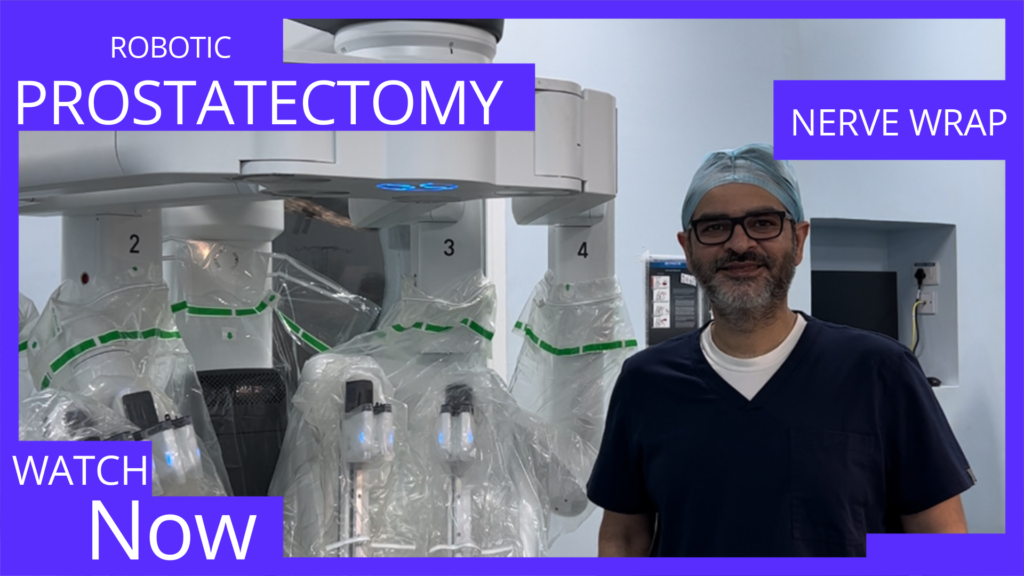
Robotic Radical prostatectomy is a surgical procedure used to treat localised stage 1 / stage 2 and early stage 3) prostate cancers. This surgery involves the removal of the entire prostate gland along with the surrounding tissues (Both the seminal vesicles and the Pelvic Lymph Nodes “Bilateral Pelvic Lymph Node Dissection”). While it is a highly effective treatment option, the procedure can result in cavernous nerve damage, which can lead to erectile dysfunction and urinary incontinence. We do Nerve Sparing Robotic Radical Prostatectomy with Amniotic Nerve Wrap to reduce the incidence of nerve damage and improve patient outcomes. Read on… for full information.
How does nerve damage occur during Robotic Radical Prostatectomy?
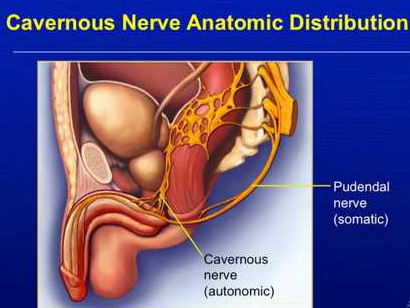
The cavernous nerves are nerves for urinary control and erectile function. These nerves run very close to the prostate and can be damaged during prostate dissection. The damage can occur due to:
• Thermal injury by electrocautery.
• The postoperative neuropraxia caused by inflammatory response to pulling of nerves during Prostate dissection.
These can damage the nerves or delay recovery of urinary continence and potency.
What is Nerve Sparing Robotic Radical Prostatectomy?
We save the Cavernous nerve from injury by the following methods:
- Use Robotic Technique
- Use laparoscopic clips for doing careful meticulous dissection, without using electro cautery ( Athermal technique ) or gentle handling without much pulling on the nerves.
Dehydrated Human Amnion/ Chorion membrane (dHACM)
Recent research has shown that the use of dehydrated human amnion/chorion membrane (dHACM) nerve wrap or amniotic membrane nerve wrap after robotic radical prostatectomy may help to reduce the incidence of nerve damage and improve patient outcomes.
How does the Amniotic Membrane work?
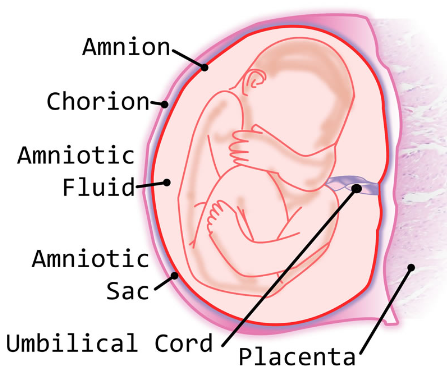
What is dehydrated human amnion/chorion membrane (dHACM)?
The dHACM is a purified human graft made from the placental amnion and chorion. The Amniotic membrane is a thin, transparent membrane that surrounds the fetus during pregnancy. It is composed of several layers, including a layer of epithelial cells, a basement membrane, and a layer of mesenchymal cells. The membrane has been used in a range of medical applications, including wound healing and tissue repair specially burn wounds.
Recent research has investigated the potential of amniotic membrane nerve wrap in the treatment of nerve injuries, particularly those that occur as a result of surgery. The membrane has been shown to promote nerve regeneration, reduce inflammation, reduce scarring and provide a protective barrier to prevent further damage.
The use of amniotic membrane nerve wrap involves wrapping the membrane around the neurovascular bundle (Cavernous nerves), which contains the nerves and blood vessels that supply the prostate gland.
Click to watch how we do it: The Future of Prostate Surgery: Nerve-Sparing Robotic Prostatectomy with Amniotic Nerve Wrap
The mechanism of action of amniotic membrane nerve wrap in promoting nerve regeneration is not fully understood, but it is thought to involve several factors:
- The membrane contains :
- stem cells, growth factors and cytokines that promote cell proliferation and differentiation, as well as,
- Anti-inflammatory and anti-fibrotic cytokine factors that reduce inflammation and scarring.
- Covering the amniotic membrane is a simple way to prevent neuroma at the site of injury and seems to prevent adhesions and perineural scarring.
The aim is to protect the nerves from scarring and adhesions and promote their regeneration in the postoperative period.
Scientific Evidence to support Dehydrated human amnion/chorion membrane (dHACM) :
Several studies have investigated the use of amniotic membrane nerve wrap after robotic radical prostatectomy, with promising results.
In a study published in the Journal of Endourology, researchers compared the outcomes of patients who underwent robotic radical prostatectomy with and without amniotic membrane nerve wrap. The study found that patients who received the nerve wrap had significantly better erectile function scores and urinary continence rates at 12 months postoperatively compared to those who did not receive the nerve wrap.
Another study published in the Journal of Urology found that the use of amniotic membrane nerve wrap was associated with a lower incidence of erectile dysfunction and urinary incontinence after robotic radical prostatectomy. The study also found that patients who received the nerve wrap had a shorter time to recovery of erectile function and continence compared to those who did not receive the nerve wrap.
Advantages of Amniotic Membrane Nerve Wrap:
- potential benefits in nerve regeneration,
- The membrane is readily available,
- easy to handle, and
- Does not require harvesting tissue from the patient’s own body. This makes the technique less invasive and reduces the risk of complications such as infection and scarring.
Conclusion:
The use of amniotic membrane nerve wrap after Nerve Sparing robotic radical prostatectomy is a significant advancement in the field of prostate cancer surgery promising a technique that has the potential to reduce the incidence of nerve damage and early return of urinary control and recovery of erectile function. The technique is safe, easy to perform, and has excellent outcomes.



